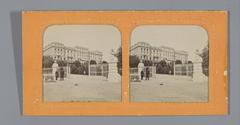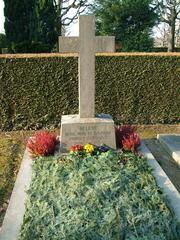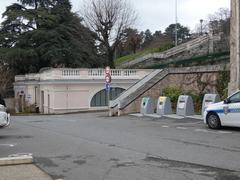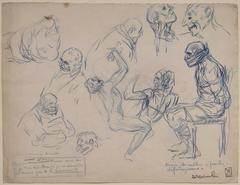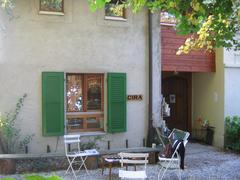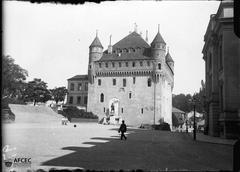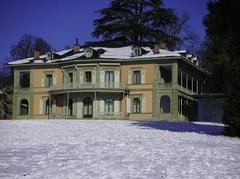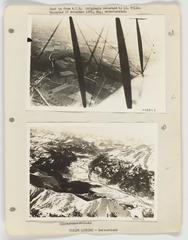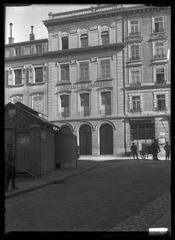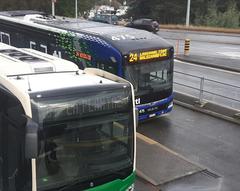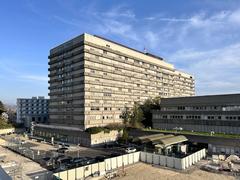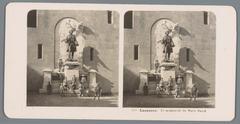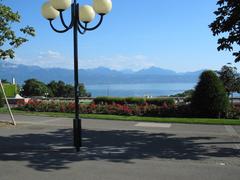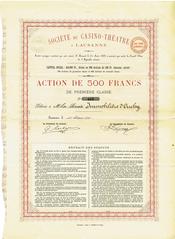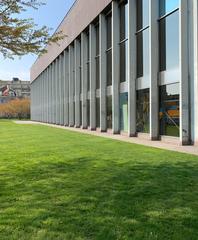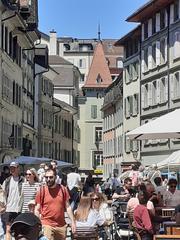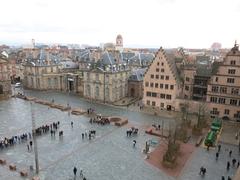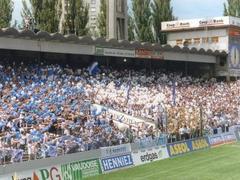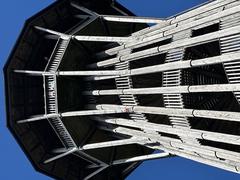Tunnel De La Barre Visiting Hours, Tickets, and Travel Guide in Lausanne, Switzerland
Date: 04/07/2025
Introduction
The Tunnel de la Barre, situated in the heart of Lausanne, Switzerland, is a remarkable feat of urban engineering and a symbol of the city’s evolution. Originally constructed in the 19th century to address Lausanne’s challenging terrain and connect distinct city districts, the tunnel has grown from a pivotal infrastructure project into an enduring landmark of urban development, architectural heritage, and sustainable mobility (lausanne.ch; fr.wikipedia.org). While the tunnel itself is reserved for vehicles, its surrounding areas—including Place de la Barre and Place du Tunnel—offer rich opportunities for exploration, blending historical significance with vibrant city life.
This comprehensive guide covers the tunnel’s historical context, architectural and geological features, practical visitor information, travel tips, and the cultural vitality of the surrounding urban fabric. Whether you are a history buff, architecture enthusiast, or a curious traveler, the Tunnel de la Barre area invites you to experience a unique facet of Lausanne.
Table of Contents
- Introduction
- Early Development and Urban Context
- Construction and Engineering
- Historical and Cultural Significance
- Heritage Conservation and Urban Renewal
- Modern Mobility and Urban Life
- Visitor Information
- Notable Events and Upgrades
- Architectural and Geological Features
- Nearby Attractions and Amenities
- Frequently Asked Questions (FAQ)
- Conclusion and Next Steps
- References
Early Development and Urban Context
Lausanne’s dramatic topography—rising nearly 500 meters from lakeshore to hilltop—has always influenced its urban planning. The Tunnel de la Barre was conceived in the mid-19th century as part of the “ceinture Pichard” ring road, designed to address the steep elevation differences and to boost connectivity between the city’s upper and lower districts (lausanne-tourisme.ch). Its location beneath Place de la Barre made it a vital artery for traffic, alleviating surface congestion and enabling the city’s economic and residential growth.
Construction and Engineering
Construction of the Tunnel de la Barre began in 1851 and was completed in 1855, under the direction of engineers Victor Dériaz and Georges Krieg after the original planner, Adrien Pichard, passed away (lausanne.ch; fr.wikipedia.org). The project was notable for its use of open trench excavation through soft molasse rock, followed by the construction of a robust stone vault to support urban structures above. The tunnel measures 56 meters in length and 9 meters in width, with grand semicircular arches (plein cintre) reaching 10.8 meters at their highest point. Buttresses and retaining walls provide stability on the water-rich, sloping terrain.
Historical and Cultural Significance
The tunnel was pivotal in Lausanne’s transformation from a medieval hilltop town to a modern city. Its creation allowed for the development of new neighborhoods beyond the original city core, including bustling commercial zones around Place du Tunnel (switzerlanding.com). The construction also revealed important geological layers and fossils, adding scientific value to its historical importance. Today, the tunnel’s presence is a testament to Lausanne’s history of innovation and adaptability.
Heritage Conservation and Urban Renewal
A defining aspect of the Tunnel de la Barre is its integration with Lausanne’s heritage conservation efforts. The tunnel’s construction was managed to protect nearby medieval structures, and ongoing upgrades have balanced modernization with respect for the city’s architectural legacy (sahc2025.epfl.ch). In recent decades, the surrounding area—including Place de la Riponne—has been revitalized through participatory urbanism, involving residents in planning, design competitions, and temporary cultural installations (lausanne.ch).
Modern Mobility and Urban Life
Today, the Tunnel de la Barre is central to Lausanne’s mobility network, facilitating the flow of traffic between major city areas and supporting sustainable urban development. Its existence enables the creation of pedestrian-friendly streets and vibrant public spaces above ground, contributing to Lausanne’s reputation as a “green and sustainable city” (lausanne-tourisme.ch). The area regularly hosts markets, performances, and cultural events, making it a hub of community life.
Visitor Information
Visiting Hours and Access
- Tunnel Access: The tunnel itself is open 24/7 for vehicles, cyclists, and pedestrians (where dedicated walkways exist). There are no restricted visiting hours.
- Surrounding Areas: Place de la Barre, Place du Tunnel, and Place de la Riponne are accessible year-round and are open public spaces.
Tickets and Guided Tours
- Tickets: No tickets are required to access the tunnel or the adjacent public spaces.
- Guided Tours: While there are no tours focused solely on the tunnel, many historical and architectural walking tours of Lausanne include the tunnel area as a point of interest. Check with Lausanne Tourisme or local providers for current offerings.
Accessibility
- Pedestrian Access: The tunnel area features barrier-separated walkways suitable for strollers and wheelchairs.
- Public Transport: Easily accessible by bus (TL line 16), metro (M2 at Riponne-Maurice Béjart), and on foot from the city center (TL official schedule).
- Cycling: Cyclists are permitted; use lights and reflective gear, especially at night.
- Mobility: The area is fully accessible for people with reduced mobility.
Travel Tips
- Best Times to Visit: Early mornings or weekends for a quieter experience.
- Nearby Facilities: Cafés, bakeries, and supermarkets are nearby; public restrooms are available in adjacent facilities.
- Event Listings: Check allevents.in and lausanne-tourisme.ch for local markets, performances, and festivals.
- Safety: The tunnel is well-lit, monitored by CCTV, and regularly patrolled.
Notable Events and Upgrades
The Tunnel de la Barre has seen periodic upgrades, including improvements to ventilation, lighting, seismic safety, and traffic management (sahc2025.epfl.ch). The redevelopment of Place de la Riponne and adjacent spaces since 2018 has included participatory design competitions and public exhibitions, fostering a strong sense of community ownership (lausanne.ch).
Architectural and Geological Features
- Architectural Style: Sturdy masonry and plein cintre arches typify Swiss civil engineering of the 1850s.
- Integration: The tunnel connects the valleys of the Flon and Louve rivers, supporting the layering of Lausanne’s urban fabric (lausanne.ch).
- Geology: Built through soft molasse rock, the tunnel’s construction exposed fossils, some of which are now displayed at the Cantonal Museum of Geology.
- Water Management: The tunnel’s design addresses natural groundwater; visible seepage highlights the area’s aquiferous geology (fr.wikipedia.org).
Nearby Attractions and Amenities
- Lausanne Cathedral: A masterpiece of Gothic architecture.
- Old Bishop’s Palace: Historic seat of Lausanne’s bishops.
- Plateforme 10: The city’s vibrant arts district.
- Sauvabelin Tower: Offers panoramic views of the city and lake.
- Markets: Regular events on Place de la Riponne.
- Cafés and Shops: Found throughout the adjacent neighborhoods.
Frequently Asked Questions (FAQ)
Is the Tunnel de la Barre open 24/7?
Yes, the tunnel is open at all times for vehicles, cyclists, and pedestrians (in designated areas).
Are tickets required to visit?
No, access is free for all modes of transit.
Is the tunnel safe for children and people with reduced mobility?
Yes, pedestrian walkways are separated and accessible, but children should be supervised.
Are there guided tours?
Architectural and historical tours of Lausanne sometimes include the tunnel; check with the local tourism office.
Are bicycles allowed?
Yes, cyclists may use the tunnel; appropriate safety gear is recommended.
What are nearby points of interest?
Lausanne Cathedral, Plateforme 10, Place de la Riponne, Sauvabelin Tower, and the Old Town are all within walking distance.
Conclusion and Next Steps
The Tunnel de la Barre encapsulates Lausanne’s unique approach to modern urban living—where engineering innovation, historical preservation, and participatory community life intersect. Explore the vibrant public spaces above, enjoy nearby markets and performances, and use the tunnel as a gateway to discovering Lausanne’s rich heritage. For real-time updates, event listings, and interactive maps, download the Audiala app and follow local tourism platforms.
References
- Lausanne Tourisme, Lausanne in Short
- Lausanne Official Site, Tunnel de la Barre Architectural Heritage
- Wikipedia, Tunnel de la Barre
- Switzerlanding, Lausanne Old Town
- SAHC 2025 Conference, Structural Analysis of Historical Constructions
- Lausanne Official Site, Riponne Tunnel Project
- Lausanne Tourism, Essential Things to See in Lausanne
- TL official schedule
- Wonderful Wanderings, Lausanne
- Allevents.in, Lausanne
- Urban Trail Lausanne
